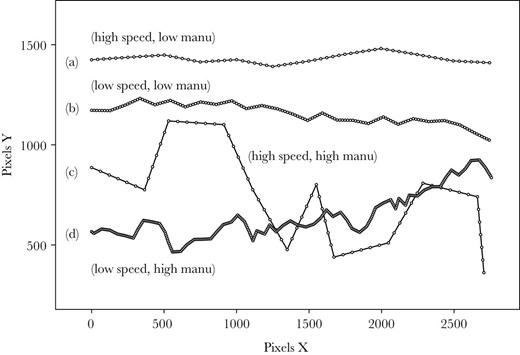- Reaction score
- 1,693
The interaction between prey and predators is an asymmetric game of life and death: unsuccessful predators go hungry, whereas unsuccessful prey are killed. As such, predation is considered one of the most pervasive selective pressures affecting individual fitness. But what performance characteristics enable individuals to escape predation? Intuitively, we expect faster individuals to be better at avoiding predation, and studies of animal performance have almost exclusively focused on the role of maximal speeds during escape from predators.
However, focusing on maximal performance vastly oversimplifies the dynamics between predators and prey. In reality, an individual’s escape performance is likely to be defined by both their speed and ability to rapidly change directions or maneuverability. We tested this idea using a custom, tablet-based game that simulated encounters between predator and prey. We conducted 2 experiments in which human subjects were asked to capture simulated on-screen prey by touching them as they moved across the tablet’s display; with prey varying in size, speed, and maneuverability.
Using these data, we were able to quantify how the function describing speed and the probability of escape differed from the relationship between maneuverability and the probability of escape. Importantly, variation in these functions would mean that small increases in speed would translate to escape success in different ways to small increases in maneuverability, and understanding these functions is essential for predicting the evolution of escape performance and its associated morphologies. We found that escape success was determined by both speed and maneuverability—slow prey could still escape predation when highly maneuverable, whereas prey that were poorly maneuverable could only escape when fast.
As small changes in speed translated into escape success in a different way to changes in maneuverability, our results highlight the importance of including both speed and maneuverability in tests of animal escape performance. Taken together, our data of simulated predator–prey interactions can be used to guide further theoretical and empirical studies exploring the evolution and conservation implications of predator–prey interactions.

 academic.oup.com
academic.oup.com
However, focusing on maximal performance vastly oversimplifies the dynamics between predators and prey. In reality, an individual’s escape performance is likely to be defined by both their speed and ability to rapidly change directions or maneuverability. We tested this idea using a custom, tablet-based game that simulated encounters between predator and prey. We conducted 2 experiments in which human subjects were asked to capture simulated on-screen prey by touching them as they moved across the tablet’s display; with prey varying in size, speed, and maneuverability.
Using these data, we were able to quantify how the function describing speed and the probability of escape differed from the relationship between maneuverability and the probability of escape. Importantly, variation in these functions would mean that small increases in speed would translate to escape success in different ways to small increases in maneuverability, and understanding these functions is essential for predicting the evolution of escape performance and its associated morphologies. We found that escape success was determined by both speed and maneuverability—slow prey could still escape predation when highly maneuverable, whereas prey that were poorly maneuverable could only escape when fast.
As small changes in speed translated into escape success in a different way to changes in maneuverability, our results highlight the importance of including both speed and maneuverability in tests of animal escape performance. Taken together, our data of simulated predator–prey interactions can be used to guide further theoretical and empirical studies exploring the evolution and conservation implications of predator–prey interactions.

Speed and maneuverability jointly determine escape success: exploring the functional bases of escape performance using simulated games
Lay Summary. Tablet-based games simulating interactions between predators and prey show that both speed and maneuverability determine escape success. Slow prey
Last edited by a moderator:



